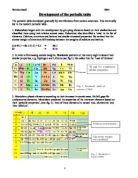The difference between Mendeleev’s and earlier attempts to classify elements is that Mendeleev’s table allowed for and was capable of adjusting to future discoveries. The modern table presents the noble gases, all gaps are filled and the elements are in order of atomic number rather than relative atomic mass. The patterns in physical properties of elements, such as densities, melting and boiling point were clearly presented in the new table.
Discovery of Gallium.
Gallium was discovered by Boisbaudran, using atomic spectroscopy. He found that the element matched with Mendeleevs predictions for ‘eka-aluminium’. Fig 3 shows some of the similarities.
Fig 3.
This led to more predicted elements being found.
Unusual Properties of Gallium
- Melting point is 29.78 ºC which suggests it is a non metal.
- Textbooks stated there is no explanation for low melting point of gallium (it is unusual).
- It has a high boiling point (2403 ºC) and low melting point which suggests that it has the widest range of any element and is also a metal.
- It is denser as a liquid than as a solid which suggests it is a non metal.
- It is shiny and conducts heat and electricity very well. Gallium easily forms alloys with mist metals and is used to create low melting alloys. This suggests that Gallium is also a metal.
The properties of gallium make it hard to classify it as either a metal or a non metal as it has characteristics of both.
Like aluminum, it dissolves in both acids and alkalis, evolving hydrogen. This is because both elements are in the same group; therefore their reactivity with other molecules is similar.
Aluminum and gallium with Hydrogen ions:
2Al (s) + 6H+ (aq) 2Al ³+ (aq) + 3H2 (g)
2Ga (s) + 6H+ (aq) 2Ga ³+ (aq) + 3H2 (g)
Aluminum and gallium with hydroxide ions:
2Al (s) + 2OH- (aq) + 6H2O (l) 2 [Al(OH)4] - (aq) + 3H2 (g)
2Ga (s) + 2OH- (aq) + 6H2O (l) 2 [Ga(OH)4]- (aq) + 3H2 (g)
(Article 1)
Very few metals behave in this way which also shows gallium is unusual. This supports the idea of aluminum and gallium being very similar in properties, clearly proving Mendeleev’s predictions to be correct.
Techniques to increase knowledge of chemical elements
There are two main in ways in which chemists have increased their knowledge on chemical elements.
- Atomic Spectroscopy
- UNILAC accelerator
An atomic emission spectrometer can discover new elements as well as increase the knowledge of discovered elements! Firstly the spectrometer excites atoms using as electric arc. The excited atoms emit light which can be split by a prism to show the emission spectrum. The spectrum consists of a series of coloured lines on a black background which are characteristics of the atoms of the element. The intensities of the lines provides knowledge of the following:
- A measure of the elements abundance.
- The composition of stars can be determined from vast distances.
- Neil Bohr interpreted that the spectrum of hydrogen showed that electrons can exist in orbits of different energies and electrons in atoms are arranged in shells and sub-shells.
- Quantum theory explains the movement and energies of particles on an atomic scale.
Neil Bohr explains that the excited atoms drop back to lower levels which then emit or absorb the energy as electromagnetic radiation and hence gives the emission/absorption spectrum. The frequency of the emitted or absorbed radiation is given by ΔE = hυ (see fig 4).
Fig 4.
In the case of hydrogen, the lines of emission correspond to different frequencies of radiation. ‘These lines are characteristics of hydrogen atoms – every type of atom has different pattern of lines’ (article 1), hence more understanding is brought out about a specific element as it also shows the electronic structure of atoms.
Fig 5.
The UNILAC Accelerator is used to fire a beam of ions at a rotating disk of a target metal (see fig. 6). The ions overcome a repulsion and fuse together to form a new element.
An example given of chromium ions and bismuth metal is shown in the equation.
24Cr + 83Bi 107Element
30Zn +82Pb 112Element
The results were a creation of element 107 and element 112.
Through this technique, chemists found that Nuclei repel because they have a positive charge and that chemical reactions involve loss or gain of electrons. Scientists can strip off the electron shells from even very heavy atoms. ‘This allows them to study quantum electrodynamics the most precise theory in physics to unprecedented levels of accuracy’ (GSI in profile).
The elements that are unstable and have a very short half-life and have decayed long ago are only known to us through UNILAC accelerator.
Fig 6, Particle beam target
Discovering to synthesizing elements
The discovery of elements began before the time of Newland’s table. Mendeleev created a table with spaces for new elements to be discovered. The remaining elements were found in the last 140 years, including the noble gases. Techniques such as atomic spectroscopy supported the discovery and production of new elements. Through time, the development of understanding of the arrangement of electrons in atoms has helped to explain the patterns of behaviour and properties of elements. Scientists began to synthesize elements, (turn an element into another). New ways of producing elements were discovered such as the UNILAC accelerator.
“… the exception proves the rule.” (article 1)
Sources
Websites:
Books:
Chemical Ideas (Salters)







